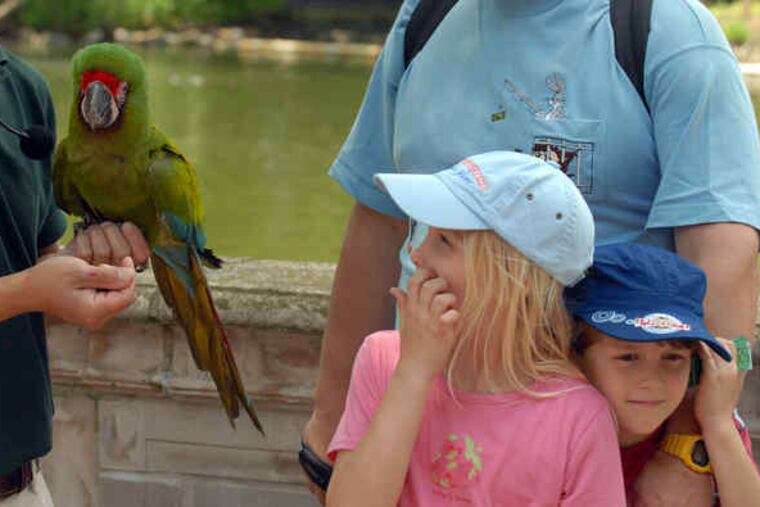Bird-watchers' paradise
The way 8-year-old Katie Trojak grilled bird trainer Phung Luu yesterday at the Philadelphia Zoo, you began to fear a bit for the man's job.

The way 8-year-old Katie Trojak grilled bird trainer Phung Luu yesterday at the Philadelphia Zoo, you began to fear a bit for the man's job.
As Luu made Bella the red-fronted macaw do tricks for the crowd outside the zoo's new $17.5 million bird exhibit, the second grader fired off questions like a Senate inquisitor.
"The question is," Luu repeated, " 'Is it true the heavier the bird, the slower it flies?' "
His answer: It depends. Sometimes, a big bird is more powerful in the air. Sometimes, it's not.
Luu, 35, a bird man with a whisperer's touch, is used to questions and has a lot of answers. But Katie? She was no slouch. "She seemed especially interested."
If Katie's wide-eyed enthusiasm catches on - if the McNeil Avian Center, which opened yesterday, inspires similar wonder among the world-weary or the oblivious - it might make the world gentler to the soul.
If only for a moment, noticing a bird may turn hardened grown-ups into kids and kids into carefree critters, happy to marvel at the creatures soaring above.
"Flight is freedom," said Michael Trojak, 45, a systems analyst from Churchville, aiming a camcorder toward his three children running circles around Luu: Katie, 6-year-old Michael Jr., and Kristi ("I'm 41/2!").
The new center caps an effort begun in 1998 to reinvent the birdhouse, which opened in 1918.
"When it was built, it was probably the leading bird facility in the country," said biologist Andrew J. Baker, the zoo's chief operating officer, who has had a lifelong fascination with birds.
The local man who helped introduce the world to Tylenol, Robert J. McNeil Jr., was the single largest private donor, giving a bit less than a third of the $17.5 million, said Sara Hertz, zoo vice president of development.
His daughter, Jody McNeil Lewis, board member and bird enthusiast, was central in securing the gift.
"She loves birds," Hertz said. "They had parrots growing up."
The McNeil family's Philadelphia roots were planted in 1879 when Robert J. McNeil Jr.'s grandfather opened a pharmacy in Kensington. In the 1950s, McNeil Laboratories, under the grandson's leadership, introduced Tylenol. He has channeled much of his philanthropy through the Barra Foundation.
About $10 million for the bird center was raised from private donors, large and small, all in hand by the end of 2007.
The state kicked in most of the rest. Budget appropriations approved by lawmakers and Gov. Rendell in 2001 and 2002 steered $7.25 million to the zoo for the center, while former Mayor John F. Street kicked in $300,000, said Kenneth Woodson, the zoo's vice president of community and government affairs.
The 11,000-square-foot exhibit hall is home to 120 birds - paradise for bird-watchers.
Although watching is a popular hobby, many people remain oblivious to birds, which Baker called "our most frequent link with the wild-animal world."
Take the Trojaks. Yes, they have a pet bird. But it wasn't until two years ago, when they hung a finch feeder in their yard, that Lori Trojak, mother of the brood, really began to appreciate birds.
A certified public accountant, she is a stay-at-home mom who also cares for her live-in mother, who has been profoundly ill for years. To say Lori Trojak's life is hectic would be putting it mildly.
Enter: The finch feeder.
When beautiful, bright-yellow goldfinches make pit stops in her yard, she emerges from a haze.
"Life is so crazy and busy these days that it gives you a moment to stop and breathe," she said, "to remember there's more to life than the craziness."
The avian center has loads of colorful, whimsical birds. But nowhere in the rain-forest wing yesterday were the colorful headliners whose glossies are on aviary-center tour placards: two curl-crested Aracaris, hand-raised at Dallas World Aquarium. (The bird is pronounced ah-ruh-SAR-ee.)
The "little boys" made their debut during members-only tours, but were a tad too friendly for their own good.
"They were landing on people's hands and arms and heads," bird-keeper Catherine Vine said. "We didn't want them walking out of here with anybody." They may return for special events or on quiet days when a bird-keeper can be on hand.
A less-charming bird trait on display yesterday: the poo drop. With tree branches dangling over pathways, it proved a hazard.
A crimson-rumped toucanet - a bird so restless, you wondered if it had downed a pound of sugar - darted onto a branch and took a bathroom break, just barely missing a male patron and, well, this reporter.
"Did it get me? Did it get me?" the man said with a tinge of panic, before scurrying away with a laugh.
Zoo folks say they are ready for such unwanted bird baths. A stash of moist wipes is but a few feet away, aviary center attendant Daniel Harrison said.
And for children on the receiving end of such a potty moment, there's even a treat:
"If you're lucky to get pooed on," Harrison said, "you get a zoo tattoo."
And if you're an adult?
"You get good luck for the rest of your life."